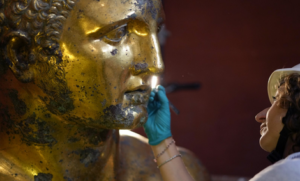Scaffolding in a niche of the Vatican Museums’ Round Hall conceal from view the work of restorers who are removing centuries of grime from the largest known bronze statue of the ancient world: the gilded Hercules Mastai Righetti.
For more than 150 years, the four-meter-tall (13-foot-tall) figure of the half-human Roman god of strength has stood in that niche, barely garnering notice among other antiquities because of the dark coating it had acquired.
But it was only after removing a layer of wax and other material from a 19th-century restoration that Vatican experts understood the statue’s true splendor as one of the most significant gilded statues of its time. Museum-goers will be able to see its grandeur for themselves once the restoration is finished, which is expected in December.
13-year-old boy with slingshot saves sister from would-be-kidnapper
“The original gilding is exceptionally well-preserved, especially for the consistency and homogeneity,” Vatican Museum restorer Alice Baltera said.
The discovery of the colossal bronze statue in 1864 during work on a banker’s villa near Rome’s Campo dei Fiori square made global headlines.
Read more: AP
Ask me anything
Explore related questions





